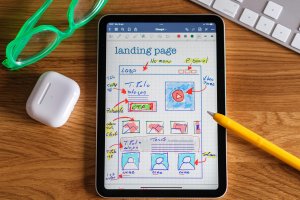After reading this article, you’ll:
- Understand the differences between low-fidelity and high-fidelity wireframes, including when and why each should be used during the app prototyping process.
- Learn how each wireframing method impacts your app’s development timeline, costs, and overall product quality, helping you make informed decisions that save time and budget.
- Gain actionable insights on integrating both wireframing techniques effectively, ensuring your app resonates with users, stakeholders, and investors alike.

Developing a successful app isn’t just about coding – it starts with a clear vision of the user experience. Wireframing and prototyping help turn ideas into tangible plans, and they come in different flavors. In particular, low-fidelity and high-fidelity wireframes are two prototyping methods that businesses and startups often weigh. Wondering whether to sketch your app idea on paper or invest in a polished digital mockup? Both approaches have their place, and understanding the differences can save you time, money, and headaches down the road. In fact, one IBM study found that fixing a software issue after launch can cost 4–5× more than addressing it during the design phase (What’s the True Cost of a Software Bug?) – a strong case for getting your wireframes right early on.
In this article, we’ll break down low-fi vs. high-fi wireframes in terms of features, cost, time, and use cases. You’ll see how each method fits into the app development lifecycle, what recent UX research and trends say, and when to use each type to maximize user testing and cost efficiency. Let’s dive in.
What Are Low-Fidelity Wireframes?
 Low-fidelity wireframes are basic, rough sketches of your app or website design. Think of grabbing a pen and sketching your app’s screens on paper – that’s low-fi. These wireframes focus on structure and layout rather than visual details. They typically use simple boxes, lines, and placeholder text to represent content and navigation, omitting things like color, styling, or exact wording (Low fidelity and high fidelity wireframes – which to use? – Justinmind). The goal is to map out what goes where and how screens connect, without getting bogged down in aesthetics. Because they’re so easy to create (often literally drawn by hand or using simple digital tools), low-fidelity wireframes can be produced in minutes or hours, making them perfect for early brainstorming and rapid iteration.
Low-fidelity wireframes are basic, rough sketches of your app or website design. Think of grabbing a pen and sketching your app’s screens on paper – that’s low-fi. These wireframes focus on structure and layout rather than visual details. They typically use simple boxes, lines, and placeholder text to represent content and navigation, omitting things like color, styling, or exact wording (Low fidelity and high fidelity wireframes – which to use? – Justinmind). The goal is to map out what goes where and how screens connect, without getting bogged down in aesthetics. Because they’re so easy to create (often literally drawn by hand or using simple digital tools), low-fidelity wireframes can be produced in minutes or hours, making them perfect for early brainstorming and rapid iteration.
The simplicity of low-fi wireframes is actually their strength. By stripping down the design to bare essentials, you encourage everyone to focus on the core user experience and flow rather than nitpicking fonts or colors. In early project stages, team members, users, and stakeholders can look at a sketch and understand the basic idea, offering feedback on the concept and content without being distracted by visual polish.
Research in UX has found that even very humble prototypes can yield powerful insights – low- and high-fidelity prototypes are equally good at uncovering usability issues in user testing (#TiSDD Method: Paper prototyping). In other words, you don’t need a fancy mockup to start learning what users need. Low-fi wireframes excel at gathering early feedback on functionality and layout because people feel free to critique a “rough draft” design (Low fidelity and high fidelity wireframes – which to use? – Justinmind).
Another benefit is speed and cost. Low-fidelity wireframes are cheap (often just marker on whiteboard or quick digital sketches) and fast to revise. If stakeholders or test users suggest changes – e.g. moving a button or adding a step to a flow – you can update the wireframe in minutes. This agility makes low-fi prototypes ideal for iterating through ideas in the initial phases of app development. Many startup product teams embrace this approach during design sprints or ideation workshops. For example, Google’s Design Sprint methodology emphasizes sketching solutions early in the week and only later firming up a prototype (How to Build a Successful Startup From App Idea to IPO | Dogtown Media). By not getting too attached to any single design, you can explore multiple concepts and pivot before any heavy resources are invested.
When to use low-fidelity wireframes: Use low-fi wireframes at the very beginning of the design process when you’re defining the product and exploring ideas. They are great for:
- Brainstorming and ideation: Quickly visualizing different layouts or user flows to decide which direction to pursue (Low fidelity and high fidelity wireframes – which to use? – Justinmind). The rough format fosters creativity since you’re not worried about fine details.
- Early user testing: Conducting simple usability tests or concept validation with target users before investing significant time. Low-fi prototypes let you test broad concepts (e.g. does the navigation make sense?) and uncover major pain points early (Low fidelity and high fidelity wireframes – which to use? – Justinmind) (Low fidelity and high fidelity wireframes – which to use? – Justinmind).
- Developer and team buy-in: Showing your engineering team a basic blueprint of the app’s screens and flow. Even a sketch on paper can help everyone understand the project scope and technical requirements upfront (Low fidelity and high fidelity wireframes – which to use? – Justinmind).
- Client or stakeholder communication (if they’re on board): Keeping internal stakeholders in the loop on the app’s structure without distracting visuals. Some clients love seeing wireframes evolve from scribbles to final design, as it involves them in the process. (However, be cautious: not all stakeholders can envision the final product from a sketch – more on that later.)
Overall, low-fidelity wireframes are the quick and nimble starting point of app design. They shine when speed is essential and you need to validate the foundation of your product. Once you have the core screens and flow figured out in low fidelity, you’ll eventually move to high fidelity to iron out the finer details.
What Are High-Fidelity Wireframes?
High-fidelity wireframes (or prototypes) are the detailed, polished design mockups that closely resemble the final app. If low-fi is a rough pencil sketch, think of high-fi as a full-color architectural rendering. High-fidelity wireframes incorporate specific visuals – real or representative text, images, typography, color schemes, and UI elements – to give an almost realistic preview of how the app will look and feel (Low fidelity and high fidelity wireframes – which to use? – Justinmind). Often, these wireframes are interactive, meaning you can click through screens and simulate user flows as if it were a real app.
Designers create high-fi prototypes using digital design tools like Figma, Sketch, or Adobe XD, applying the brand’s styles and following standard UX/UI patterns. The result isn’t just a skeleton, but a near-complete interface design. For example, a high-fidelity wireframe of a login screen would show the actual placement of logos, input fields styled as they would appear in the app, placeholder profile images, button states, etc., rather than just labeled boxes. Because of this detail, high-fi prototypes take more effort and time to produce – but they’re incredibly valuable for fine-tuning and final validation.
High-fidelity wireframes are typically used in later stages of design, after the basic concept and structure have been established. At this point, the team is focusing on specifics: the exact wording of copy, the visual hierarchy, the spacing and alignment of elements, and the interactive behaviors (transitions, animations, error states, etc.). Because high-fi prototypes mirror the final product, they enable more thorough usability testing for things like look-and-feel and interactive flows.
 Testers can react to the actual design elements (e.g. “I thought that icon was clickable” or “I didn’t notice that call-to-action because of its color”), which helps the team catch nuanced UX issues that wouldn’t be apparent in a sketch. High-fidelity prototyping is also useful for evaluating complex user interactions that a low-fi simply can’t simulate (Low fidelity and high fidelity wireframes – which to use? – Justinmind) – for instance, swiping through a carousel or filling out a multi-step form with validations.
Testers can react to the actual design elements (e.g. “I thought that icon was clickable” or “I didn’t notice that call-to-action because of its color”), which helps the team catch nuanced UX issues that wouldn’t be apparent in a sketch. High-fidelity prototyping is also useful for evaluating complex user interactions that a low-fi simply can’t simulate (Low fidelity and high fidelity wireframes – which to use? – Justinmind) – for instance, swiping through a carousel or filling out a multi-step form with validations.
However, high-fidelity wireframes come with higher cost and time investment. They require more design expertise and tooling. As a HubSpot design article notes, high-fi wireframes “consume a lot of design time and will be more expensive to produce.” (The Differences in Wireframe Fidelity: From Low to High Fidelity Wireframes ) If you’re working with an external design agency or contractor, creating a full interactive prototype will be a line item in the budget. The trade-off is that by the time you’re building a high-fi prototype, you’ve hopefully reduced risk by vetting the concept with low-fi drafts. In other words, you spend the extra time on high fidelity only once you’re reasonably confident in the direction. (It wouldn’t make sense to invest weeks in a pixel-perfect design, only to realize the core idea doesn’t resonate with users – that’s what low-fi sketches protected you against.)
When to use high-fidelity wireframes: High-fi prototypes enter the scene after initial iterations have proven out the concept. Key scenarios for using high-fidelity wireframes include:
Refining the user experience
Once basic layouts and flows are confirmed with low-fi, high-fi wireframes help iron out details like visual hierarchy, content, and micro-interactions. This is the time to fine-tune things like button placements, form field designs, or navigation menus based on feedback from earlier tests (Low fidelity and high fidelity wireframes – which to use? – Justinmind). High fidelity is appropriate when changes are more about details than drastic structural overhauls.
Testing advanced interactions and usability
If your app has complex workflows or interactive elements (e.g. a drag-and-drop interface, or an interactive map), a high-fi prototype lets you observe users as they would behave in the real app (Low fidelity and high fidelity wireframes – which to use? – Justinmind). You can gather precise feedback on what works and what doesn’t in terms of UI/UX. For example, you might discover through testing a high-fi prototype that users aren’t noticing a custom icon or that a transition animation is confusing – insights you’d miss on a static wireframe.
Stakeholder demos and investor pitches
When it’s time to impress external stakeholders – whether it’s an executive team, a sales demo, or potential investors – a high-fidelity prototype is far more effective than a napkin sketch. A polished, interactive wireframe demonstrates professionalism and helps non-designers visualize the final product clearly (The Differences in Wireframe Fidelity: From Low to High Fidelity Wireframes ). Many startups use high-fi app prototypes in pitch meetings or beta client demos to showcase the concept. In fact, having a tangible prototype dramatically improves your chances of raising funds; it’s practically impossible to get significant investment without showing the product vision in action (How Much Does it Cost to Develop an App?).
Development hand-off and specification
High-fidelity wireframes serve as a blueprint for developers once you move into the coding phase. They include the detailed design specifications, from exact hex color codes to pixel distances and font sizes. This reduces ambiguity for the dev team. Rather than guessing how the app should look or behave, developers can follow the high-fi prototype as a reference, which helps prevent costly redesigns later. A well-crafted high-fidelity prototype can be accompanied by design system guidelines or annotations, ensuring that what gets built stays true to the intended design (Low fidelity and high fidelity wireframes – which to use? – Justinmind).
In summary, high-fidelity wireframes are best used when you need a near-real representation of your app – either to validate the fine details, to gain buy-in from people who need to see polish, or to serve as a final model before development. They require more resources, but they pay off by revealing issues that only surface in a realistic setting and by rallying everyone around a concrete vision of the product.
Low-Fi vs High-Fi: Key Differences at a Glance
Low-fidelity and high-fidelity wireframes differ across several dimensions. Here’s a quick comparison of how they stack up:
Level of Detail
Low-fi wireframes are simplistic and use abstract placeholders (e.g. blocks labeled “Image” or “Button”) with minimal or no styling. They give a rough draft of the interface. High-fi wireframes, in contrast, are highly detailed and closely resemble the final product, complete with specific fonts, colors, images, and even dummy content text (Low fidelity and high fidelity wireframes – which to use? – Justinmind). High-fi designs often look like screenshots of a real app, whereas low-fi looks like a sketch or outline.
Visual Design & Aesthetics
Low-fi designs intentionally lack visual polish – no branding elements, no fancy graphics. This keeps the focus on layout and functionality (Low fidelity and high fidelity wireframes – which to use? – Justinmind). High-fi prototypes incorporate the visual design elements (brand logos, style guides, typography, iconography) to provide a realistic preview of the UI. Stakeholders find it easier to visualize the end result with high-fi wireframes because they can see the proposed look and feel in context (Low fidelity and high fidelity wireframes – which to use? – Justinmind).
Interactivity and Functionality
Low-fidelity wireframes are often static or only lightly interactive (maybe a simple click-through of images or PDFs). They typically do not include complex interactive elements, which limits testing of detailed user flows (Low fidelity and high fidelity wireframes – which to use? – Justinmind). High-fidelity prototypes, on the other hand, can be made interactive using prototyping software – users can click buttons, navigate menus, trigger animations, etc. This allows for extensive usability testing, as high-fi wireframes can simulate actual user interactions and show how the app responds (Low fidelity and high fidelity wireframes – which to use? – Justinmind).
Creation Time & Cost
Low-fi wireframes are quick and cheap to create. A UX designer (or even a founder with a pencil) can draft the key screens in a day or two. Because they require little effort, changes are inexpensive – you can redraw or reposition elements without worrying about wasted work. High-fi wireframes require a larger investment. Designers might spend multiple weeks refining a high-fi prototype, especially for a complex app.
This translates to higher cost if you’re paying for design services. As one UX expert puts it, you should ensure you have the necessary “time, budget, and approvals” before diving into high-fidelity design (The Differences in Wireframe Fidelity: From Low to High Fidelity Wireframes ).
In numbers, a basic mobile app prototype might be built for as little as $5,000 using lean UX principles, whereas developing a full MVP or beta with a backend can cost tens of thousands (How Much Does it Cost to Develop an App?) (How Much Does it Cost to Develop an App?). The high-fi prototype sits in between – not as costly as coding the app for real, but more costly than a whiteboard sketch.
Flexibility & Iteration
Low-fi prototypes offer maximum flexibility. Since they’re low-effort, teams are not overly attached to them and can discard or overhaul designs freely when new ideas emerge (5 Common Low-Fidelity Prototypes and Their Best Practices | IxDF). This makes them ideal for the divergent phase of design where you want to try many approaches. High-fi prototypes, being more involved, are less disposable – changes take more work, so teams tend to iterate on them when changes are smaller or more certain. In practice, you might go through several low-fi versions, but you’ll aim to finalize decisions by the time you’re in high fidelity.
Use Cases & Stage in Lifecycle
Low-fidelity wireframes are best for early-stage validation – mapping out user flows, getting stakeholder alignment on what the app should do, and testing core usability without visual distractions (Low fidelity and high fidelity wireframes – which to use? – Justinmind). High-fidelity wireframes are suited for later-stage validation and presentation – refining the user experience details and demonstrating the product to those who need to be sold on its value (executives, investors, end-users in a pilot) (#TiSDD Method: Paper prototyping). In the typical product development timeline, you start with low-fi sketches during ideation, and after a few rounds of feedback and improvements, you progress to building a high-fi prototype to finalize the design before development (Wireframing & Prototyping in Healthcare Apps | Dogtown Media).
As you can see, neither low-fi nor high-fi is “better” universally – they serve different purposes. A successful app project will actually use both types of wireframes at different phases. Low-fi is a thinking and exploring tool, while high-fi is a testing, convincing, and specifying tool. Let’s talk about how to strategically apply each one during your app’s development journey.
When to Use Low-Fidelity Wireframes in Your App Project
Use low-fidelity wireframes early and often in the beginning phases of your app development. Here are specific points in the lifecycle and scenarios where low-fi prototyping makes the most impact:
Product Definition & Ideation
The moment you have an app idea and a list of features, start sketching. Low-fi wireframes help you brainstorm the app’s layout and navigation before any code is written or any graphic design is done. For example, if you’re building a food delivery app, you might sketch a home screen with categories, a restaurant list page, an order cart, etc. This ensures you’ve thought through the necessary screens and how they connect.
It’s much easier (and cheaper) to identify missing pieces or unrealistic flows at the whiteboard stage than after development begins. Many top app developers insist on wireframing as a first step for this reason – it’s part of the planning that can cut overall development time dramatically by preventing false starts (Product Design Is Crucial to Mobile Apps | Dogtown Media).
Early User Feedback (Prototype Testing)
Before investing in pixel-perfect design, you can create a clickable low-fidelity prototype (even if it’s just linking sketched screens in a slide deck) to test with real users. At this stage, you’re checking basic usability: Can users find the core features? Do they understand the workflow? A low-fi prototype is ideal here because users will focus on functionality. They won’t say “I don’t like the color” – instead, they’ll tell you if a step is confusing or if they expected a different feature.
Crucially, if something’s not working, you haven’t sunk tons of time into it yet. You can pivot easily. A study from the Human Factors community concluded that low-fi paper prototypes uncovered essentially the same usability problems as higher-fidelity versions (#TiSDD Method: Paper prototyping). So, you can confidently use sketches to catch the lion’s share of UX issues in these early tests.
Iterating on Concepts
Low-fidelity wireframes are your best friend when you need to iterate rapidly. Perhaps after some user testing or team discussion, new ideas emerge – a different navigation scheme, an extra feature, a changed priority. You can quickly adjust your wireframes or draw new ones to reflect the changes. This might happen through several cycles. For example, you might try out two or three different layouts for a dashboard screen in low-fi form to see which one people prefer conceptually. Because it’s so quick, you’re able to fail fast and fail cheap, arriving at a solid direction without derailing your timeline. UX teams often create multiple low-fi prototypes (A/B versions) and test them internally or with a small user sample to decide which to take into high-fidelity.
Team Brainstorming & Communication
In cross-functional teams (startups especially), low-fi wireframes act as a common language between designers, developers, and non-technical stakeholders. A simple diagram on a whiteboard can spark discussion: “Should that screen come before this one? What if we add a shortcut here?” Everyone from the CTO to the marketing lead can give input early on. It’s far easier to adjust course from feedback given on a sketch than feedback given on a nearly finished product. Low-fi wireframes keep the whole team aligned on what you’re building and why.
They can be pinned on a wall or shared in a slide deck for reference in meetings. This transparency helps avoid misunderstandings later (for instance, a developer building something different from what the designer intended, or a stakeholder being surprised by the app’s flow). As Dogtown Media’s own experience notes, a project that might take six months can sometimes be completed in half the time with proper upfront planning and wireframing, thanks to fewer miscommunications and course-corrections mid-stream (Product Design Is Crucial to Mobile Apps | Dogtown Media).
Resource-Constrained MVPs
If you’re bootstrapping or racing to an MVP (Minimum Viable Product) release, low-fi wireframes let you allocate your limited resources smartly. You can wireframe the entire app and identify which parts are critical and which can be simplified for version 1. This prioritization is a core tenet of lean startup strategy. For example, you might realize through wireframing that a proposed feature adds a lot of complexity to the interface; you could then decide to postpone that feature to a later release, focusing on the essentials first.
By doing this at the wireframe stage, you avoid building unnecessary features. It’s a cost-saving practice: one tech agency found that concentrating on validated features via prototypes “lowers costs and improves the consumer-facing product” by preventing work on things that won’t pan out (How Long Does It Take to Develop a Mobile App? | Dogtown Media).
In short, lean heavily on low-fidelity prototyping in the early chapters of your app’s story – when you’re defining, validating, and iterating on the concept. It’s a low-cost insurance policy against building the wrong app. Once you have confidence in your wireframed solution (and stakeholder buy-in on the basics), you’ll transition into high-fidelity to refine and polish.
When to Shift to High-Fidelity Wireframes
After you’ve vetted your app’s concept and core usability with low-fi wireframes, it’s time to shift into high gear with high-fidelity prototypes. Here’s when and why you should use high-fidelity wireframes in your development cycle:
After Proof of Concept Is Solid
You’ll know you’re ready for high-fi when your low-fi wireframes have gone through a few rounds of feedback and the overall structure isn’t changing drastically. At this point, your team should agree on the user flow and the major screens. Now, moving to high-fidelity will add value by addressing how those screens look and behave. Essentially, use high-fi to refine, not to define.
For example, if everyone’s aligned that your e-commerce app will have a product list, product detail, and checkout screens in that order (thanks to low-fi prototyping), high-fi can now determine what the product cards look like, how the “Add to Cart” button behaves, and so on. Starting high-fidelity design too early (before consensus on the concept) can lead to wasted effort on beautiful designs that get scrapped – avoid that by nailing the basics first (The Differences in Wireframe Fidelity: From Low to High Fidelity Wireframes ).
Finalizing User Experience Details
High-fidelity wireframes are invaluable for fine-tuning the user experience. This includes visual hierarchy (making sure the most important information catches the user’s eye), clarity of icons and labels, and alignment with any platform design guidelines (like Apple’s Human Interface Guidelines or Google’s Material Design). During this stage, you might conduct moderated usability tests or A/B tests with the high-fi prototype to compare variations of a UI element. Because the prototype looks real, feedback will be specific: e.g., “Users are missing the filter option – maybe it’s not prominent enough on the screen.”
You can experiment with visual tweaks in the high-fidelity comp (make the filter button bigger or more colorful) and test again. High-fi prototypes let you iterate on design nuance in a way low-fi can’t. This design polish can have measurable effects – for instance, a high-fidelity prototype test might show that a different color scheme improves task completion or that adding an illustration on an empty state makes users more likely to engage. These are the kinds of insights leading UX teams glean in the high-fi stage.
Stakeholder Presentations & Approvals
When you reach a milestone where you need approval from a client, board, or higher management, a high-fidelity prototype is typically expected. Business stakeholders, especially non-technical or visual thinkers, often cannot fully grasp the product vision from wireframes full of gray boxes. High-fidelity prototypes speak their language – they see the app as customers would. This can dramatically speed up buy-in. Instead of lengthy meetings explaining “imagine this button will eventually look nice,” you come in with a clickable model that looks nice already.
It reduces ambiguity and inspires confidence. As one service design expert put it, high-fi prototypes play to their strengths when it comes to presenting to management or other stakeholders unfamiliar with low-fi concepts (#TiSDD Method: Paper prototyping). The result? Faster approvals and a smoother path to development. We’ve seen startups secure partnerships or pilot program deals because their polished prototype made the solution tangible to a client, whereas a rough sketch might not have done the trick.
Marketing and Pre-launch User Demos
In some cases, you might use a high-fidelity prototype as a stand-in for the app before it’s fully built. For example, if you’re generating buzz for your startup, you could create a promotional video or interactive demo using the high-fi prototype. Since it looks real, you can get away with showcasing it as “here’s what’s coming.” This can be valuable for gathering pre-launch user feedback or even taking pre-orders/signups.
It’s much easier for early adopters to react to an accurate representation of the app than to conceptual descriptions. High-fi prototypes have been used at tech conferences or sales pitches to demonstrate apps that are still in development – essentially de-risking the marketing by ensuring the design resonates with the target audience beforehand.
Development Kickoff & Handoff
One of the most practical uses of high-fidelity wireframes is as the definitive reference for developers once coding starts. Before a single line of code, your engineering team should ideally walk through the entire high-fidelity prototype with the design team. This ensures that every intended feature and design element is understood. The prototype can be annotated with measurements and behaviors, or integrated into a design handoff tool (like Zeplin or Figma’s inspect mode) to provide CSS values, etc. By having this clear blueprint, you reduce the chances of the built app deviating from the approved design.
It also helps identify any technical challenges early – if a particular screen animation in the prototype is hard to code, developers and designers can discuss alternatives before development is in full swing. Essentially, the high-fi wireframe and its specifications become part of the contract of what will be built. This practice often prevents costly rework: it’s much cheaper to adjust the prototype and clarify requirements than to have developers implement something and then change it later because it didn’t match the design vision. In agile teams, the high-fi prototype might even be updated continuously and serve as a living design document that stays one step ahead of development sprints.
In summary, transition to high-fidelity wireframes once you have a validated framework for your app and you’re ready to sweat the details. High-fi is about execution and assurance: executing a polished UX/UI and assuring all stakeholders that the product will delight users. It is typically the last step in design before actual development and often runs in parallel with early development to answer questions and guide the build. By the end of the high-fidelity stage, you should have a click-through prototype that looks and behaves almost exactly as you want the final product to – effectively de-risking the design so implementation can focus on functionality.
The Payoff: Why Using Both Fidelity Levels Leads to a Better (and Cheaper) App
Using low-fidelity and high-fidelity wireframes at the appropriate stages isn’t just a process formality – it has real benefits for your project’s success, timeline, and budget. Here are some key advantages, backed by industry insights and statistics:
Catch and Fix Issues Early
Perhaps the biggest advantage is identifying usability or design problems before they become expensive. As mentioned, low-fi prototypes can uncover the majority of usability issues. By iterating in sketches, you ensure the foundation is solid. This early problem-finding saves money. Consider the oft-cited statistic from IBM: a bug or design flaw caught after a product’s launch can cost 4–5 times more to fix than if it was caught during design (What’s the True Cost of a Software Bug?).
Some estimates go even further, saying it can be up to 10× or more costly by the time a product is in production. Every hour your team spends refining a wireframe could be saving dozens of hours of redevelopment later. In the context of UX, that could mean the difference between a smooth launch and a scramble to patch the app because users are getting confused. Wireframing is essentially a form of risk mitigation – find the issues on paper when the cost is near zero.
Shorter Development Timelines
Time is critical for startups. Prototyping can significantly accelerate development by ironing out requirements and design before coding. A clear example is the impact of thorough wireframing on project timelines: one Dogtown Media case noted that a project taking six months without proper planning could be done in three months with it (Product Design Is Crucial to Mobile Apps | Dogtown Media).
That’s a 50% reduction in time-to-market simply by front-loading design thinking. Additionally, by breaking the process into prototype → MVP → full product, you create tangible milestones and avoid backtracking. Remember the development phase breakdown we discussed: prototype in weeks, MVP in a couple of months, then building out full features (How Long Does It Take to Develop a Mobile App? | Dogtown Media) (How Long Does It Take to Develop a Mobile App? | Dogtown Media).
If you skipped the prototype and dove straight into building, you might spend those same weeks or months coding features that ultimately get removed or changed because you didn’t prototype them first. In contrast, teams that prototype and test can move forward with development confidently, often hitting their targets faster. It’s the classic scenario of “slow down now to speed up later.” A little patience with low-fi wireframes can shave off months of engineering time.
Better Stakeholder Satisfaction (Fewer Revisions)
When clients or executives are involved, using the appropriate fidelity at the right time leads to smoother approvals. Early on, showing low-fidelity wireframes sets the expectation that things will evolve – stakeholders feel included in shaping the product. Later, showing them a high-fidelity prototype gives them assurance of how the product will look.
This two-step engagement (first on concept, then on visuals) means by the time development delivers the working app, stakeholders have effectively seen it already in the prototype. Surprises are minimized. It’s not uncommon in projects without proper prototyping for a client to say at development completion, “This isn’t what I imagined.” Prototyping prevents that, because everyone has literally seen what to expect. The result is fewer revision cycles post-launch and a product that meets the business goals more closely.
High-fidelity prototypes, in particular, are great for securing consensus. As one UX source pointed out, a high-fi wireframe helps stakeholders see that the team has “addressed all the nuances” of the design and how it will work (The Differences in Wireframe Fidelity: From Low to High Fidelity Wireframes ), building trust in the final deliverable.
Improved User Testing Outcomes
User research is far more fruitful when you have the right prototype for the questions at hand. Low-fi and high-fi wireframes both play a role in user testing, and together they maximize what you learn. Early stage, you might test three different low-fi concepts to see which overall approach users prefer – something that would be too costly to do in high fidelity. Later, you might test the high-fi prototype to fine-tune wording or visual cues.
By splitting testing across fidelities, you get qualitative feedback on big-picture ideas and quantitative or detailed feedback on UI elements. This layered testing approach can boost your app’s usability metrics significantly. For instance, imagine initial low-fi tests reveal navigation issues (so you fix those), and subsequent high-fi tests reveal some confusion with icon meanings (so you tweak those).
The final product launches with neither of those problems, leading to higher user satisfaction scores and task success rates. Numerous UX case studies show that products developed with iterative prototyping end up with measurably better usability – often achieving double-digit percentage improvements in efficiency or error reduction compared to if they had not prototyped. All of this translates to a better user experience and higher likelihood of your app gaining and retaining users.
Cost Efficiency and Value for Money
Especially for startups mindful of their burn rate, prototyping is an investment that pays for itself. Sure, you might allocate a few thousand dollars to extra design work for prototypes, but you potentially save tens of thousands by avoiding rebuilding features or doing major app revisions post-launch. As Dogtown Media’s analysis notes, trying to leap straight to a final product without thorough testing and validation is a “fatal flaw” that can burn through budget with little to show (How Much Does it Cost to Develop an App?).
A lean approach – prototype, validate, then build – ensures that every dollar spent on development is more likely to create something users actually want. It also can make the difference in getting funded or not; having a prototype to show investors is almost a prerequisite, and those who have a strong prototype “always fare better” in fundraising. In short, prototyping is not an added expense; it’s a way of making sure the big expenses are absolutely worth it.
By leveraging both low-fidelity and high-fidelity wireframing methods, you essentially get the best of both worlds: the creativity, speed, and flexibility of sketching, plus the precision, realism, and persuasive power of a polished prototype. This one-two punch de-risks the app development journey. You’ll know you’re building the right app, you’ll have evidence to back design decisions, and you’ll keep your team and stakeholders on the same page throughout.
Sketch, Prototype, Succeed
In the dynamic world of app development, startups and businesses that prototype thoughtfully are the ones that consistently deliver successful products. Low-fidelity and high-fidelity wireframes aren’t an either/or choice but sequential tools – each with unique strengths – that guide your project from a rough idea to a refined application. In the early stages, grab that marker or open your favorite wireframing tool and sketch out your concept. Those scrappy low-fi wireframes will clarify your vision, expose pitfalls, and rally your team around a shared understanding (Wireframing & Prototyping in Healthcare Apps | Dogtown Media). As the project matures, don’t hesitate to add fidelity. Turn those sketches into an interactive, high-fi prototype that wows users and stakeholders alike, and use it to perfect the user experience before a single line of code is committed.
The difference between skipping these steps and embracing them is palpable. Teams that forgo prototyping often learn their lessons the hard way – through costly bug fixes, confusing user feedback after launch, or lukewarm investor interest. On the flip side, teams that iterate from low-fi to high-fi move forward with confidence. They enter development with a blueprint everyone trusts, and they launch a product that has already been test-driven and approved by real users. The development lifecycle is much smoother when at each stage you can say, “We’ve validated this. We know what we’re building and why.”
So, when should you use low-fidelity vs. high-fidelity wireframes? The answer is simple: use both, at the right times. Start low-fi when you’re exploring and problem-solving; shift to high-fi when you’re refining and preparing to build. This approach isn’t heavy or slow – in fact, it streamlines your path to market. As we’ve highlighted, a bit of extra effort in design can cut your overall timeline and budget significantly by preventing mistakes and misunderstandings (Product Design Is Crucial to Mobile Apps | Dogtown Media). It’s a classic case of “measure twice, cut once.”
In practice, you might follow a workflow like this: Outline your app’s core screens in low fidelity and review them with key stakeholders. Iterate until everyone gets the vision and major questions are answered. Then create a high-fidelity prototype of the most important flows and test it with users (and impress a potential client or investor with it!). Tweak the details as needed. Finally, hand that prototype to your developers as the single source of truth and start coding. With this method, by the time you launch, you’ve essentially done a mini launch already through your prototypes – so you can be much more confident in success.
In a friendly, advisory tone: whether you’re a startup founder or a product manager at a company, embracing low-fi and high-fi wireframing will de-risk your app development journey. It’s about making smart decisions at the sketch stage and at the pixel-perfect stage. Do this, and you’ll not only build a better app, but you’ll also do it more efficiently. At Dogtown Media, we’ve seen firsthand how a strategic prototyping process can turn a “good idea” into a great product with far fewer hiccups. By understanding when to use a quick sketch versus when to sweat the details, you empower your team to create an app that’s user-tested, stakeholder-approved, and primed for market success.
In the end, the low-fi vs high-fi debate isn’t a competition – it’s a collaboration. Use low-fidelity wireframes to shape the right product, and high-fidelity wireframes to ship the product right. Happy prototyping, and good luck with your app development!
Frequently Asked Questions (FAQs)
1. What is the main difference between low-fidelity and high-fidelity wireframes?
Low-fidelity wireframes are basic, simplified sketches that outline an app’s structure without detailed design elements, focusing on layout and functionality. High-fidelity wireframes, in contrast, are detailed, visually polished prototypes that closely resemble the final app, including interactive elements, specific design choices, and realistic content.
2. When should I use low-fidelity wireframes during app development?
Use low-fidelity wireframes during the initial stages of app development, particularly for brainstorming, concept validation, and rapid iteration. They’re ideal for early user feedback, exploring multiple ideas quickly, and clarifying core functionality.
3. When is it appropriate to transition from low-fidelity to high-fidelity wireframes?
Transition to high-fidelity wireframes once the app’s foundational structure and primary user flows are confirmed. High-fidelity prototypes are best for refining user experience details, conducting advanced usability testing, securing stakeholder approvals, and preparing detailed specifications for developers.
4. How do wireframes affect my overall app development cost and timeline?
Proper wireframing can significantly reduce development costs and timelines. By identifying issues early through low-fidelity wireframes, you avoid expensive late-stage revisions. High-fidelity wireframes further streamline development by clearly communicating design specifics, reducing misunderstandings, and ensuring efficient coding.
5. Can I skip low-fidelity wireframes and start directly with high-fidelity designs?
It’s possible, but generally not recommended. Skipping low-fidelity wireframes can lead to costly mistakes and misalignment among stakeholders. Starting with low-fidelity helps clarify the app’s core functionality quickly and inexpensively, ensuring that high-fidelity design efforts are focused and effective.





